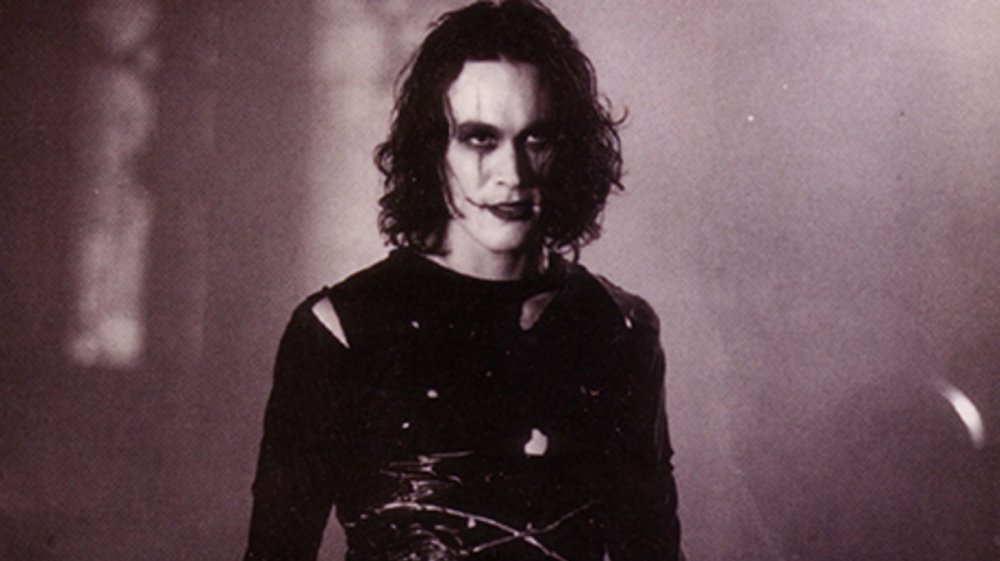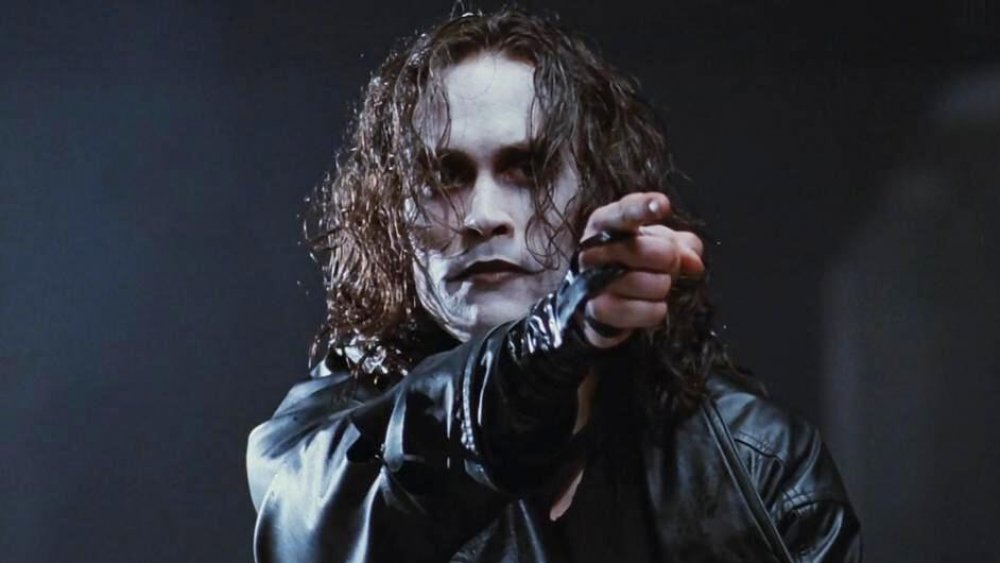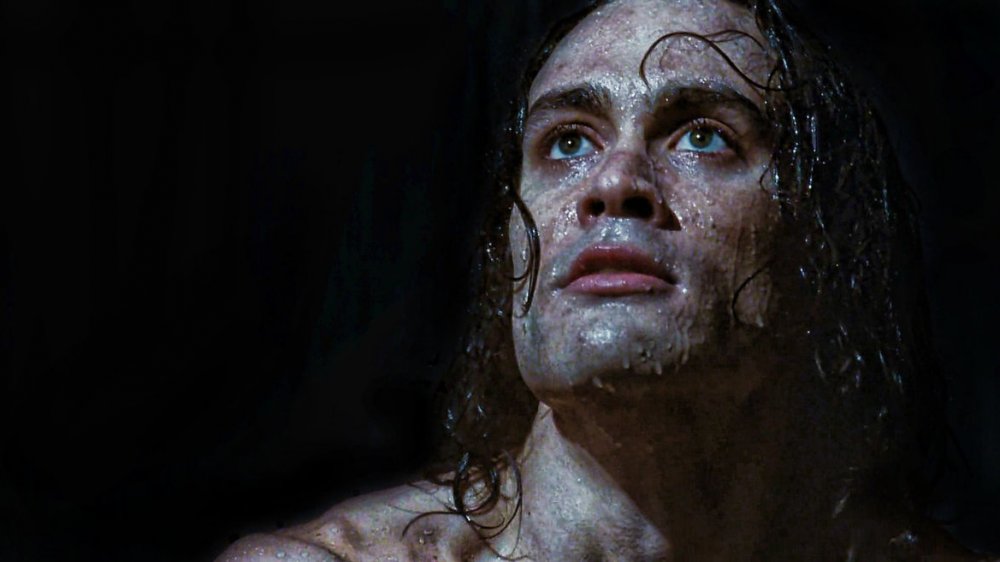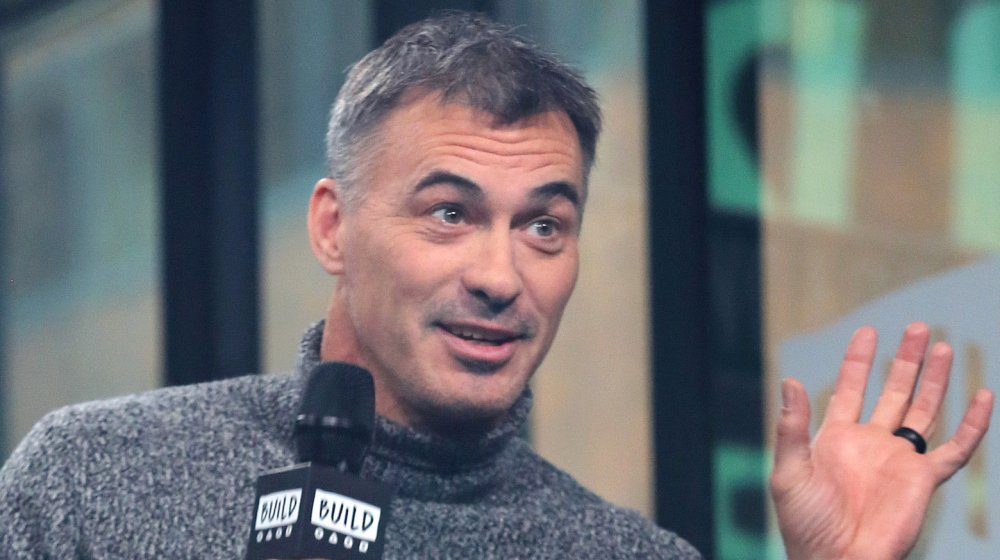Here's How They Finished The Crow After Brandon Lee Died During Filming
Brandon Lee, the son of the late, legendary martial artist and actor Bruce Lee, was just beginning to come into his own as a silver screen talent when his life was cut tragically short at the age of 28. Lee famously lost his life as a result of a freak accident on the set of his final film, 1994's The Crow, and had he not, he may very well have gone on to become a major star. In his review of The Crow, no less an authority than the great Roger Ebert wrote, "Brandon Lee clearly demonstrates ... that he might have become an action star, had he lived ... It is a sad irony that this film is not only the best thing he accomplished, but is actually more of a screen achievement than any of the films of his father."
The film starred Lee as Eric Draven, who along with his girlfriend Shelley (Sofia Shinas) is murdered in his apartment by a group of thugs on the night before Halloween, "Devil's Night," in Detroit. A year after the incident, guided by a crow, Eric returns to the land of the living — crawling out of his grave to track down and exact bloody revenge on those responsible.
Lee had only a few days' work left on the film when he reported to the set shortly after midnight on March 31, 1993 (via Entertainment Weekly). On deck for that night was a scene near the movie's beginning, in which Eric — entering his apartment with a bag of groceries — is immediately shot by a gangster named Funboy, portrayed by actor Michael Massee. It was to be a routine shoot, involving blanks and "squibs," exploding fake blood packets placed on the actor, but everything went terribly wrong, owing to an oversight by a special effects technician weeks prior.
A series of failures led to Brandon Lee's fatal accident
One of the more detailed descriptions of what happened that fateful morning was given by Dave Brown, a firearm safety specialist for the television and film industry, during a chat with Film Courage. Brown described a cascading chain of failures that ultimately ended with Lee shot in the abdomen even though the gun used during the scene was, of course, technically loaded with blanks. Two weeks prior to filming that scene, though, the same gun had been used in a close-up shot, during which it was loaded with "dummy cartridges" — live rounds that had had all of the gunpowder dumped out. Unfortunately, these cartridges' primers were intact, and at some point, the actor handling the gun apparently had pulled the trigger. Brown described how this caused the slug to be expelled a mere inch or two forward, where it became lodged in the barrel. After the shoot, an effects technician simply emptied the cartridges — crucially, without checking the barrel for obstructions — and returned the gun to storage.
On the night of the accident, the same gun was loaded with blanks, which Brown said can contain up to twice as much gunpowder as a normal, live round. Once again, the effects tech failed to properly check the gun before loading it, and they also failed to properly instruct Massee as to how to "cheat the angle" — that is, how to not point the gun directly at the "target" when firing. With a fully loaded cartridge full of gunpowder in the chamber, a round lodged in the barrel, and the cameras rolling, Massee aimed at Lee and pulled the trigger; the bullet punctured Lee's abdomen and lodged close to his spine. Nobody noticed Lee had actually been shot until after director Alex Proyas yelled "Cut," and the actor failed to get up. Lee was rushed to the hospital, where doctors were unable to stop his internal hemorrhaging after five hours of surgery. He was pronounced dead that afternoon.
Early digital trickery was used to help finish The Crow
After a great deal of soul-searching, Proyas and the rest of The Crow's cast and crew arrived at the conclusion that Lee would have insisted that they finish the film. With most of the actor's scenes completed, it was up to special effects house Dream Quest to fill in the blanks, which they accomplished in a number of ways. For the scene in which a newly-returned-from-the-grave Eric returns to his old apartment, for example, unused footage of Lee was used, with the actor's image digitally composited into a shot of the apartment set. For a few other key images, however, the effects technicians turned to techniques that were, in 1993, ridiculously cutting edge.
Proyas brought in a relatively green stunt performer by the name of Chad Stahelski, who had been good friends with Lee and had a similar build. For a handful of scenes, including the one in which Eric sports his eerie makeup for the first time, approaching his window as lightning briefly illuminates the room, Stahleski stood in for Lee during shooting. Then, Dream Quest used previously captured footage of Lee to digitally graft the actor's face on Stahleski's body. The resulting shots certainly benefit from their brevity and from the darkness in which they were shot, but even today, the effect holds up remarkably well.
The Crow was, of course, dedicated to Lee's memory, and it had a modestly successful theatrical run before developing a massive cult following upon its home video release. It's a great flick, and a fitting tribute to a talent lost far too soon — but according to Stahleski, its legacy goes quite a bit beyond that.
Brandon Lee's death made movie sets much safer
Stahelski would go on to become a highly-regarded stunt performer, and he would also — somewhat ironically — co-create one of the most gun-heavy franchises in film history in John Wick. In a 2019 interview with Bleeding Cool, Stahelski opened up about the loss of his friend and about how, if The Crow had been abandoned after Lee's death, film sets might not be as safe today.
"Brandon's accident was a lot of little dumb things that got by, but it's groupthink. All the people involved were very, very smart. You just get tired, you make one little mistake, it compounds," Stahelski explained. "It was a safety standard that definitely changed the industry with firearms. You know where that leads to? John Wick is 90% guns, firearms. A lot of the safety or the methodology we use, it came about because of that accident ... I know a great deal about that story, and there's no one thing that you could point a finger at, it was a lot of little dumb mistakes that shouldn't have happened."
Stahelski went on to stand one hundred percent behind Proyas' decision to finish The Crow through whatever means he had available. "To this day, I still believe that Brandon would have wanted the thing done, and done well, and today it's still a cult classic, it's still one of my favorite films," he said. "I'm proud of the work. That situation, obviously, it's unchangeable, so at least it came out the way it did. It was a good testament to who he was."



